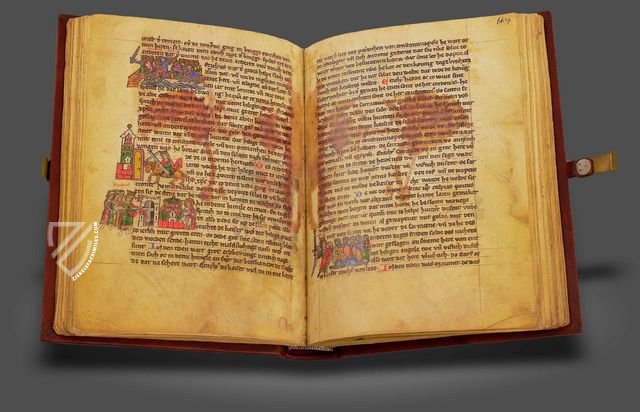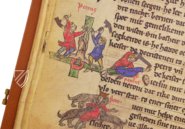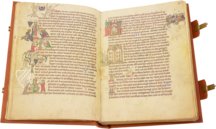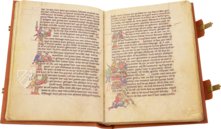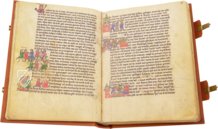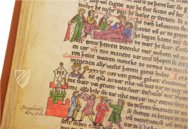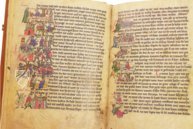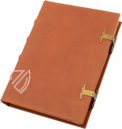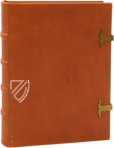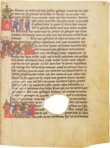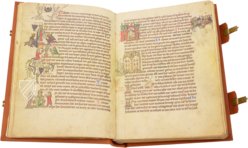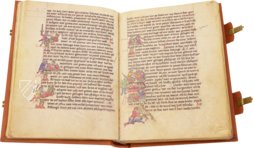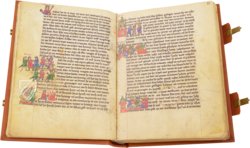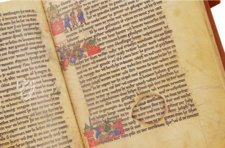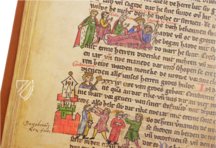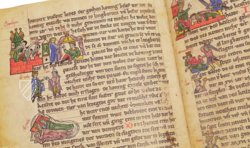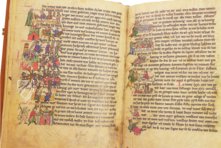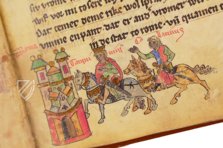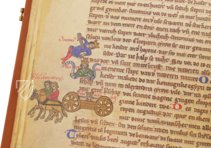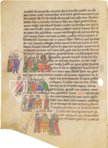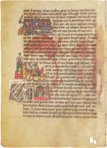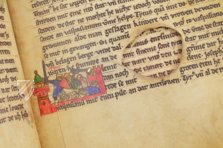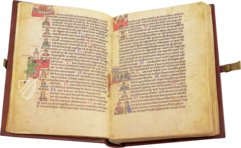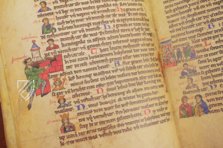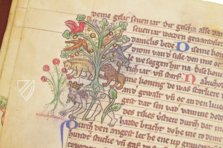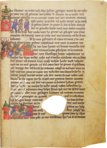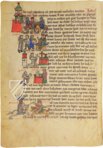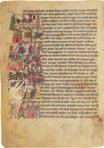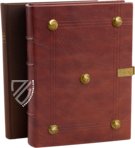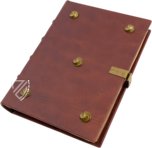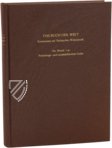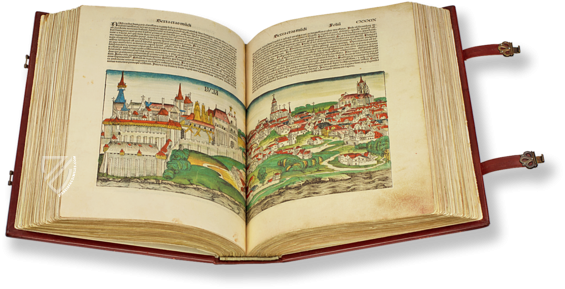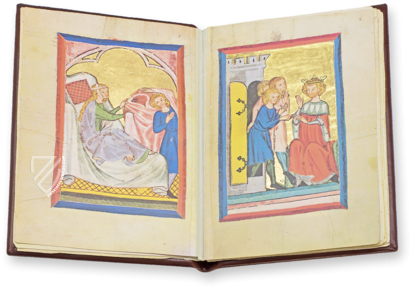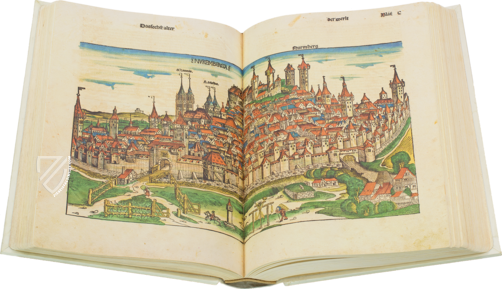Book of The World – The Saxon World Chronicle
(1,000€ - 3,000€)
The Saxon World Chronicle is the earliest world chronicle in the German speaking world to be written in prose, not the verse form that was previously common. It is recorded in numerous manuscripts and was written in the 13th century. Whereas early Christian world chronicles were based entirely on the Bible, early medieval scribes attempted to interpret world events in a new way. However, the original text was written in Latin, the universal language of scholarship. In order to make the texts accessible to ordinary people, a German-language version of the Chronicle of World History was produced. The Gotha Codex was the first and at the same time the most splendid transmission of the Saxon World Chronicle. Accompanied by brightly colored and realistic illumination, the Chronicle recounts the history of the world from its creation through the events of antiquity to the Investiture Controversy of the 11th century. In a perfect symbiosis of illustration and text, the detailed miniature paintings illuminate the most important historical events of the Christian world.
Book of the World: The Saxon World Chronicle
The Saxon World Chronicle depicts the most important historical events of the Christian world in an admirable symbiosis of text and illustration. Initiated with the story of Cain and Abel, the creation of the world, and the sequential stories of the Old and New Testaments, the Saxon World Chronicle relates history from antiquity to the barbarian migrations and the Investiture Controvery between the Holy Roman Emperor and the Pope. No harrowing detail of Christian history was left out.
Scholarship that is open to the Laity
World chronicles that were created in the early Christian period were completely Bible-oriented. Great early-medieval writers such as St. Jerome and Eusebius created a new variety that interpreted events in world history. These great thinkers nevertheless penned their writings in Latin, the universal language of the educated. In order to make the works of the learned accessible to general population, it was decided in the 13th century to create a German-language chronicle of world history.
A Book as Rich in History as its Content
The Saxon World Chronicle was first created in the magnificent Gothaer Codex. Brilliant writer and illuminators worked on this codex together, which was stored in Wittenberg until the 17th century, before it was brought to Gotha. The codex was thought to have been lost after the Soviet occupation, taken as a spoil of war back to St. Petersburg. However it was returned to Gotha a short time thereafter.
A Perfect Interaction of Text and Illustration
The miniatures of this codex, which is counted as being among the most excellent illuminated manuscripts in all of European art, depicts in astounding exactness and detail the events which are related in the text. For example, the seven days of the week were assigned seven Roman gods and for the embellishment of this association, the following pages told of the seven fabled kings of Rome. The splendidly designed color illustrations are ordered so that they are found directly next to the corresponding text. Consequently, the most important moments of the narrative enter the imagination of the reader with the aid of the magnificently colored illustrations.
Codicology
- Alternative Titles
- Buch der Welt: Die sächsische Weltchronik
- Size / Format
- 332 pages / 31.0 × 22.5 cm
- Origin
- Germany
- Date
- 1270/1279
- Epochs
- Style
- Script
- Gothic Textura
- Illustrations
- About 500 color and filigree miniatures
- Content
- The texts include, among others, the Origin of the Saxons, the Genealogy of the Guelphs and the Genealogy of the Counts of Flanders
Book of The World – The Saxon World Chronicle
The Overthrow and Death of Emperor Justinian II
The Byzantine Emperor Justinian II was an ambitious ruler, but his despotism generated much opposition to his reign. After he was overthrown for the second time in 711, he was abandoned by his soldiers in favor of the exiled general Bardanes, who assumed the regnal name Philippicus. Already wearing a crown, he is depicted wielding a sword while slaying Justinian II and his son Tiberius. Below, Emperor Philippicus holds a scepter, but his hair has changed from blonde to brown and he is now bearded.
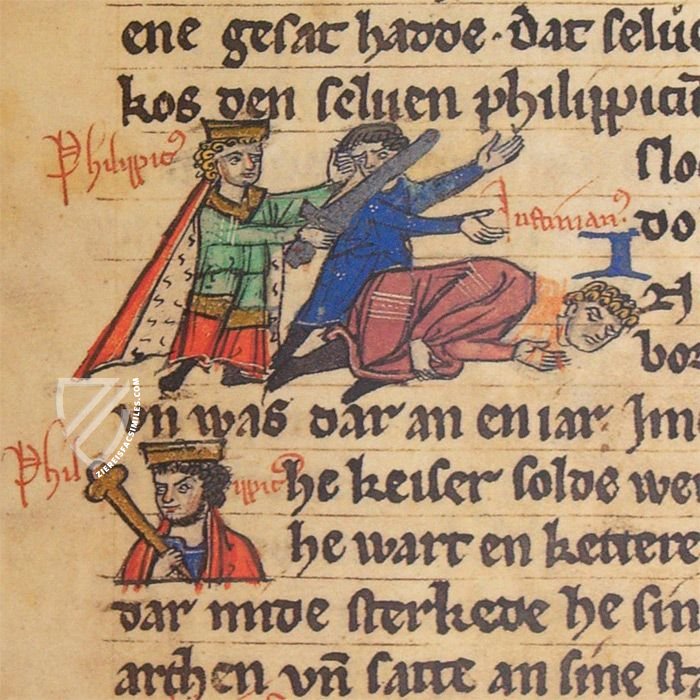
Book of The World – The Saxon World Chronicle
Holy Roman Emperor Henry III
The uppermost image of the page shows Henry III, already crowned and accompanied by his wife Agnes, while he is consecrated as emperor by Pope Clement II, who stands on the right with an open book and a flowering twig. Below them, a tonsured priest speaks to a carpenter concerning a prophecy about his son Hildebrand.
At the bottom, Henry and his wife are sleeping in a fortified camp as the Emperor’s dream portending the Investiture Crisis is illustrated in the lower margin: with his tonsure, huge horns, and empty hanging sleeves, Hildebrand – later Pope Gregory VII – throws his son – later Emperor Henry IV – into the dirt. Both their hands and faces are dirty, emphasizing that they will both be tarnished by the conflict between pope and emperor.

#1 Buch der Welt - Die sächsische Weltchronik
Language: German
(1,000€ - 3,000€)
#2 Buch der Welt: Die sächsische Weltchronik (Deluxe Edition)
Language: German
(1,000€ - 3,000€)
- Treatises / Secular Books
- Apocalypses / Beatus
- Astronomy / Astrology
- Bestiaries
- Bibles / Gospels
- Chronicles / History / Law
- Geography / Maps
- Saints' Lives
- Islam / Oriental
- Judaism / Hebrew
- Single Leaf Collections
- Leonardo da Vinci
- Literature / Poetry
- Liturgical Manuscripts
- Medicine / Botany / Alchemy
- Music
- Mythology / Prophecies
- Psalters
- Other Religious Books
- Games / Hunting
- Private Devotion Books
- Other Genres
- Afghanistan
- Armenia
- Austria
- Belgium
- Belize
- Bosnia and Herzegovina
- China
- Colombia
- Costa Rica
- Croatia
- Cyprus
- Czech Republic
- Denmark
- Egypt
- El Salvador
- Ethiopia
- France
- Germany
- Greece
- Guatemala
- Honduras
- Hungary
- India
- Iran
- Iraq
- Israel
- Italy
- Japan
- Jordan
- Kazakhstan
- Kyrgyzstan
- Lebanon
- Liechtenstein
- Luxembourg
- Mexico
- Morocco
- Netherlands
- Palestine
- Panama
- Peru
- Poland
- Portugal
- Romania
- Russia
- Serbia
- Spain
- Sri Lanka
- Sweden
- Switzerland
- Syria
- Tajikistan
- Turkey
- Turkmenistan
- Ukraine
- United Kingdom
- United States
- Uzbekistan
- Vatican City
- A. Oosthoek, van Holkema & Warendorf
- Aboca Museum
- Ajuntament de Valencia
- Akademie Verlag
- Akademische Druck- u. Verlagsanstalt (ADEVA)
- Aldo Ausilio Editore - Bottega d’Erasmo
- Alecto Historical Editions
- Alkuin Verlag
- Almqvist & Wiksell
- Amilcare Pizzi
- Andreas & Andreas Verlagsbuchhandlung
- Archa 90
- Archiv Verlag
- Archivi Edizioni
- Arnold Verlag
- ARS
- Ars Magna
- ArtCodex
- AyN Ediciones
- Azimuth Editions
- Badenia Verlag
- Bärenreiter-Verlag
- Belser Verlag
- Belser Verlag / WK Wertkontor
- Benziger Verlag
- Bernardinum Wydawnictwo
- BiblioGemma
- Biblioteca Apostolica Vaticana (Vaticanstadt, Vaticanstadt)
- Bibliotheca Palatina Faksimile Verlag
- Bibliotheca Rara
- Boydell & Brewer
- Bramante Edizioni
- Bredius Genootschap
- Brepols Publishers
- British Library
- C. Weckesser
- Caixa Catalunya
- Canesi
- CAPSA, Ars Scriptoria
- Caratzas Brothers, Publishers
- Carus Verlag
- Casamassima Libri
- Centrum Cartographie Verlag GmbH
- Chavane Verlag
- Christian Brandstätter Verlag
- Circulo Cientifico
- Club Bibliófilo Versol
- Club du Livre
- CM Editores
- Collegium Graphicum
- Collezione Apocrifa Da Vinci
- Comissão Nacional para as Comemorações dos Descobrimentos Portugueses
- Coron Verlag
- Corvina
- CTHS
- D. S. Brewer
- Damon
- De Agostini/UTET
- De Nederlandsche Boekhandel
- De Schutter
- Deuschle & Stemmle
- Deutscher Verlag für Kunstwissenschaft
- DIAMM
- Droz
- E. Schreiber Graphische Kunstanstalten
- Ediciones Boreal
- Ediciones Grial
- Ediclube
- Edições Inapa
- Edilan
- Editalia
- Edition Deuschle
- Edition Georg Popp
- Edition Leipzig
- Edition Libri Illustri
- Editiones Reales Sitios S. L.
- Éditions de l'Oiseau Lyre
- Editions Medicina Rara
- Editorial Casariego
- Editorial Mintzoa
- Editrice Antenore
- Editrice Velar
- Edizioni Edison
- Egeria, S.L.
- Eikon Editores
- Electa
- Emery Walker Limited
- Enciclopèdia Catalana
- Eos-Verlag
- Ephesus Publishing
- Ernst Battenberg
- Eugrammia Press
- Extraordinary Editions
- Fackelverlag
- Facsimila Art & Edition
- Facsimile Editions Ltd.
- Facsimilia Art & Edition Ebert KG
- Faksimile Verlag
- Feuermann Verlag
- Folger Shakespeare Library
- Franco Cosimo Panini Editore
- Friedrich Wittig Verlag
- Fundación Hullera Vasco-Leonesa
- G. Braziller
- Gabriele Mazzotta Editore
- Gebr. Mann Verlag
- Gesellschaft für graphische Industrie
- Getty Research Institute
- Giovanni Domenico de Rossi
- Giunti Editore
- Graffiti
- Grafica European Center of Fine Arts
- Guido Pressler
- Guillermo Blazquez
- Gustav Kiepenheuer
- H. N. Abrams
- Harrassowitz
- Harvard University Press
- Helikon
- Hendrickson Publishers
- Henning Oppermann
- Herder Verlag
- Hes & De Graaf Publishers
- Hoepli
- Holbein-Verlag
- Houghton Library
- Hugo Schmidt Verlag
- Idion Verlag
- Il Bulino, edizioni d'arte
- ILte
- Imago
- Insel Verlag
- Insel-Verlag Anton Kippenberger
- Instituto de Estudios Altoaragoneses
- Instituto Nacional de Antropología e Historia
- Introligatornia Budnik Jerzy
- Istituto dell'Enciclopedia Italiana - Treccani
- Istituto Ellenico di Studi Bizantini e Postbizantini
- Istituto Geografico De Agostini
- Istituto Poligrafico e Zecca dello Stato
- Italarte Art Establishments
- Jan Thorbecke Verlag
- Johnson Reprint Corporation
- Josef Stocker
- Josef Stocker-Schmid
- Jugoslavija
- Karl W. Hiersemann
- Kasper Straube
- Kaydeda Ediciones
- Kindler Verlag / Coron Verlag
- Kodansha International Ltd.
- Konrad Kölbl Verlag
- Kurt Wolff Verlag
- La Liberia dello Stato
- La Linea Editrice
- La Meta Editore
- Lambert Schneider
- Landeskreditbank Baden-Württemberg
- Leo S. Olschki
- Les Incunables
- Liber Artis
- Library of Congress
- Libreria Musicale Italiana
- Lichtdruck
- Lito Immagine Editore
- Lumen Artis
- Lund Humphries
- M. Moleiro Editor
- Maison des Sciences de l'homme et de la société de Poitiers
- Manuscriptum
- Martinus Nijhoff
- Maruzen-Yushodo Co. Ltd.
- MASA
- Massada Publishers
- McGraw-Hill
- Metropolitan Museum of Art
- Militos
- Millennium Liber
- Müller & Schindler
- Nahar - Stavit
- Nahar and Steimatzky
- National Library of Wales
- Neri Pozza
- Nova Charta
- Oceanum Verlag
- Odeon
- Orbis Mediaevalis
- Orbis Pictus
- Österreichische Staatsdruckerei
- Oxford University Press
- Pageant Books
- Parzellers Buchverlag
- Patrimonio Ediciones
- Pattloch Verlag
- PIAF
- Pieper Verlag
- Plon-Nourrit et cie
- Poligrafiche Bolis
- Presses Universitaires de Strasbourg
- Prestel Verlag
- Princeton University Press
- Prisma Verlag
- Priuli & Verlucca, editori
- Pro Sport Verlag
- Propyläen Verlag
- Pytheas Books
- Quaternio Verlag Luzern
- Reales Sitios
- Recht-Verlag
- Reichert Verlag
- Reichsdruckerei
- Reprint Verlag
- Riehn & Reusch
- Roberto Vattori Editore
- Rosenkilde and Bagger
- Roxburghe Club
- Salerno Editrice
- Saltellus Press
- Sandoz
- Sarajevo Svjetlost
- Schöck ArtPrint Kft.
- Schulsinger Brothers
- Scolar Press
- Scrinium
- Scripta Maneant
- Scriptorium
- Shazar
- Siloé, arte y bibliofilia
- SISMEL - Edizioni del Galluzzo
- Sociedad Mexicana de Antropología
- Société des Bibliophiles & Iconophiles de Belgique
- Soncin Publishing
- Sorli Ediciones
- Stainer and Bell
- Studer
- Styria Verlag
- Sumptibus Pragopress
- Szegedi Tudomànyegyetem
- Taberna Libraria
- Tarshish Books
- Taschen
- Tempus Libri
- Testimonio Compañía Editorial
- Thames and Hudson
- The Clear Vue Publishing Partnership Limited
- The Facsimile Codex
- The Folio Society
- The Marquess of Normanby
- The Richard III and Yorkist History Trust
- Tip.Le.Co
- TouchArt
- TREC Publishing House
- TRI Publishing Co.
- Trident Editore
- Tuliba Collection
- Typis Regiae Officinae Polygraphicae
- Union Verlag Berlin
- Universidad de Granada
- University of California Press
- University of Chicago Press
- Urs Graf
- Vallecchi
- Van Wijnen
- VCH, Acta Humaniora
- VDI Verlag
- VEB Deutscher Verlag für Musik
- Verlag Anton Pustet / Andreas Verlag
- Verlag Bibliophile Drucke Josef Stocker
- Verlag der Münchner Drucke
- Verlag für Regionalgeschichte
- Verlag Styria
- Vicent Garcia Editores
- W. Turnowski Ltd.
- W. Turnowsky
- Waanders Printers
- Wiener Mechitharisten-Congregation (Wien, Österreich)
- Wissenschaftliche Buchgesellschaft
- Wissenschaftliche Verlagsgesellschaft
- Wydawnictwo Dolnoslaskie
- Xuntanza Editorial
- Zakład Narodowy
- Zollikofer AG

